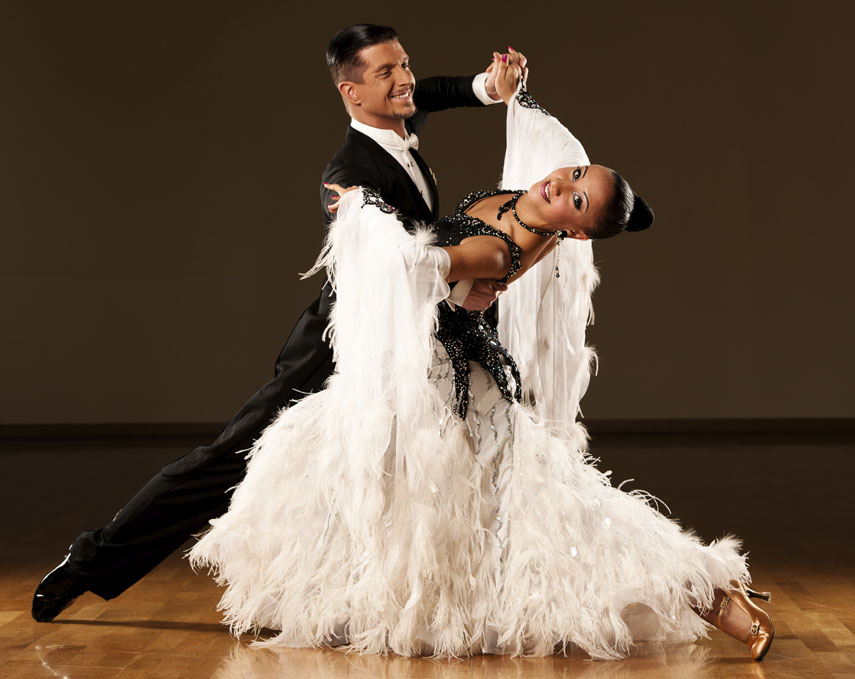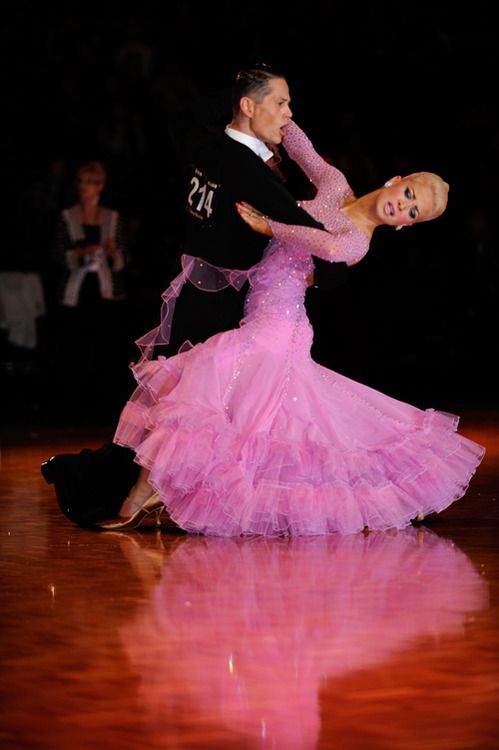Ballroom Dances


Ballroom Dances
Waltz
The elegant sweeping movement of the Waltz gives dancers a chance to practice balance and move lightly with ease.
HISTORY OF WALTZ:
Considered the mother of present day dances, the Waltz began in southern Germany in the 17th century. The popularity of the Waltz grew with the music of Johann Strauss and eventually blossomed in the 20th century. It is the basis for many dances and is popular today all over the world.
MUSIC:
The Waltz is written in 3/4 time and has a slow to medium tempo with the musical accent occurring on the first beat of each measure. The basic count for Waltz is 1, 2, 3. Faster tempo Waltz is called Viennese Waltz.
CHARACTERISTICS:
The basic components of Waltz are walking steps and side steps. Rise and Fall and Body Sway are some of the styling characteristics which make the simplest Waltz patterns elegant and beautiful.
Tango
The Tango is one of the most beautiful of all the dances. It is characterized by earthy and dramatic movements.
HISTORY OF TANGO:
The Tango began in the West Indies and found its way to Argentina where it was stylized by the Gauchos. It became the rage in 1921 after the silent screen star Rudolph Valentino brought this romantic dance to millions in “The Four Horsemen of the Apocalypse.” More recently, it has been danced in movies such as “True Lies” and “Scent of a Woman.” Today, the Tango is considered the “dancer’s dance” and becomes a favorite of all who learn it.
MUSIC:
Tango music is usually written in 2/4 or 4/4 timing.
Foxtrot
The Foxtrot provides a good foundation for all dances and is often called the “get-acquainted” or “first impression” dance.
HISTORY OF FOXTROT:
In 1913, Harry Fox a vaudeville comedian, introduced a trot to a ragtime song in the 1913 Ziegfeld Follies that pushed other trots into the background. It became America’s most popular dance and remains so to this day as the standard of social dances.
MUSIC:
Foxtrot music is written in 2/4 or 4/4 time. The first and third beats are accented in 4/4 time. The range of Foxtrot tempos makes it possible to consider Foxtrot as though it were three dances: Slow Foxtrot; Medium Foxtrot; and Fast Foxtrot, also called Society Tempo.
Viennese Waltz
From Strauss Waltzes and Tchaikovsky Ballets to music by contemporary artists, Viennese Waltz music has inspired people to dance for generations.
HISTORY OF VIENNESE WALTZ:
The Waltz developed in Central Europe from the Austrian dance known as the Landler.
The fast whirling of partners held as if in an embrace shocked polite society. The music of Johann Strauss and the famous ballrooms of Vienna popularized the faster version known as the Viennese Waltz.
MUSIC:
Viennese Waltz is basically Waltz music played at a much quicker tempo. While slow Waltz is played at 28-36 measures per minute (MPM), Viennese Waltz is played at 50-60 MPM. It is usually played in 3/4 time, but some Viennese Waltz’s are written in 6/8 time.
Quickstep
As you study the Quickstep you will soon understand why this speedy dance is the light-hearted favorite of all accomplished dancers. When this lively music is accompanied by a proficient understanding of acceleration and change of speed, the couple portrays the ultimate combination of agility and elegance.
HISTORY OF QUICKSTEP:
The quickstep developed in the golden age of the Charleston dance craze of the 1920s. British dancers in England began combining the smooth steps of the Charleston — minus the energetic kicks — with the rhythm and flow of the Foxtrot, which was also enormously popular at the time. For many dancers, the foxtrot proved too slow in tempo, however, and as the swinging big bands began to play a faster beat, dancers followed suit and created what became known as the Quick Foxtrot. Eventually, it became known as the “Quickstep” and evolved into its own distinctive dance style.
Although the quickstep was heavily influenced by the jazz culture of the period, it owes some of its movements to the equally popular Afro-Cuban and Latino dance crazes of the 1920s and 1930s. Its rapid tempo and quick changes borrowed from the tango and the rumba, while the gliding, elegant “walking” steps are a nod to its origins in the foxtrot. While it relies heavily on forms, the quickstep also easily lends itself to improvisation so that advanced students and professionals who master the fundamentals can perform beautifully in competitions as well as on the dance floor.
Peabody
The Peabody is an up-tempo, turn of the century era dance that is a big hit for the consummate social dancer. These days, it may be obscure in comparison to dances like Swing or Quickstep, but anyone who tries the Peabody instantly understands it’s appeal: It’s fun.
Set to tempos far beyond a comfortable Foxtrot or Swing, the Peabody is, essentially, the ballroom equivalent of a Merengue.
Patterns from both Foxtrot, Quickstep, and even Country Western can be easily grafted in, and it helps to complete the fast end of the tempo range for big band music.

